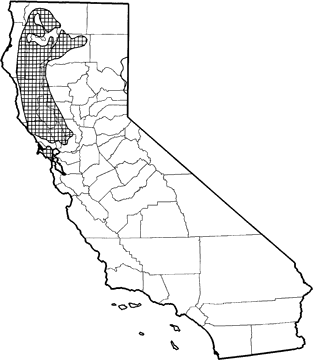
Sonoma Chipmunk
Distribution, Abundance, and Seasonality
DISTRIBUTION, ABUNDANCE AND SEASONALITY Common resident of open forests, chaparral, brushy clearings, and streamside thickets from sea level to 1830 m (0-6000 ft) (Ingles 1965, Burt and Grossenheider 1976) in the North Coast and Klamath Ranges of northern California, from the Klamath River south to San Francisco Bay, and from the coast to the western edge of the Sacramento Valley (Johnson 1943). Prefers dense chaparral and shrub-seedling-sapling stages of digger pine, oak, black oak woodland, and ponderosa pine forests. Also found in Douglas-fir, white fir, redwood, incense cedar, madrone, manzanita, ceanothus, and serviceberry (Johnson 1943). Associated with logs, stumps, snags, rocks, and litter in these habitats.

Range Map
Specific Habitat Requirements
Feeding: Sonoma chipmunks are herbivorous. They forage among small branches of bushes and on ground for acorns, fungi, and seeds of manzanita, ceanothus, and gooseberry. Often bury seeds in many different places (scatter-hoarding) for later use.
Cover: Use dense shrubs, logs, stumps, snags, litter, rock piles, and burrows for cover.
Reproduction: Nests are located in logs, stumps and burrows.
Water: No data found.
Pattern: Sonoma chipmunk habitat consists of tree/ shrub ecotones, chaparral, small brushy clearings in forests, and riparian thickets.
Species Life History
Activity Patterns: Diurnal activity; may hibernate in winter.
Seasonal Movements / Migration: Non-migratory.
Home Range: Smith (1977) found home ranges ol females overlapped; individuals foraged close to one another, but not within sight.
Territory: No data found; may defend only the vicinity of the burrow.
Reproduction: Breed from February to July. One litter per yr of 3-7 young. Gestation period about 30 days. Individuals mature at 1 yr.
Niche: Sonoma chipmunks may be preyed upon by long-tailed weasels, bobcats, badgers, gray foxes, and various hawks and owls. This species is sympatric with T. amoenus, T. ochrogenys, and T. senex. Sonoma chipmunks potentially compete for food with these other 3 chipmunks, and with mule deer, black bears, wild pigs, turkeys, California quail, and various other rodents, birds, and insects.
Sources & References
California Department of Fish and Game, 1999.
California's Wildlife, Sacramento, CA.
Written by: T. Harvey, C. Polite, reviewed by: M. White, edited by: M. White
Burt, W. H., and R. P. Grossenheider. 1976. A field guide to the mammals. 3d ed. Houghton Mifflin Co, Boston, MA. 289pp. Ingles, L. G. 1965. Mammals of the Pacific States. Stanford Univ. Press, Stanford, CA. 506pp.
Johnson, D. H. 1943. Systematic Review of the Chipmunks (genus Eutamias) of California. Univ. Calif. Publ. Zool. 48:63-143. Smith, S. F. 1977. Social structure of chipmunk populations and its relation to resource availability and exploitation. Ph.D. Diss., Univ. Calif., Berkeley. 401pp.
California Animal Facts | California's Wildlife